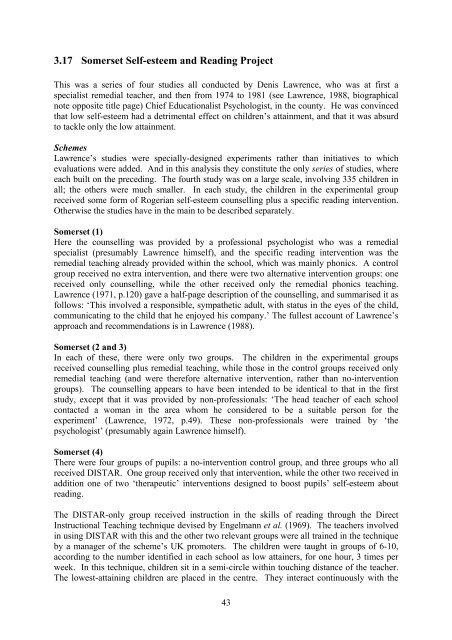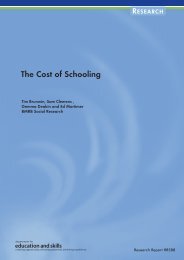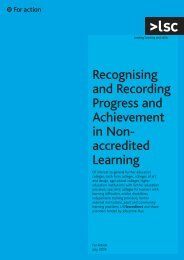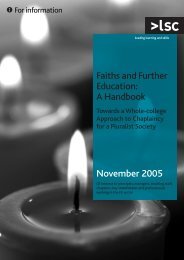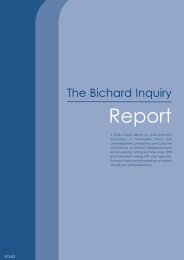What Works for Children with Literacy Difficulties? - Digital ...
What Works for Children with Literacy Difficulties? - Digital ...
What Works for Children with Literacy Difficulties? - Digital ...
You also want an ePaper? Increase the reach of your titles
YUMPU automatically turns print PDFs into web optimized ePapers that Google loves.
3.17 Somerset Self-esteem and Reading Project<br />
This was a series of four studies all conducted by Denis Lawrence, who was at first a<br />
specialist remedial teacher, and then from 1974 to 1981 (see Lawrence, 1988, biographical<br />
note opposite title page) Chief Educationalist Psychologist, in the county. He was convinced<br />
that low self-esteem had a detrimental effect on children’s attainment, and that it was absurd<br />
to tackle only the low attainment.<br />
Schemes<br />
Lawrence’s studies were specially-designed experiments rather than initiatives to which<br />
evaluations were added. And in this analysis they constitute the only series of studies, where<br />
each built on the preceding. The fourth study was on a large scale, involving 335 children in<br />
all; the others were much smaller. In each study, the children in the experimental group<br />
received some <strong>for</strong>m of Rogerian self-esteem counselling plus a specific reading intervention.<br />
Otherwise the studies have in the main to be described separately.<br />
Somerset (1)<br />
Here the counselling was provided by a professional psychologist who was a remedial<br />
specialist (presumably Lawrence himself), and the specific reading intervention was the<br />
remedial teaching already provided <strong>with</strong>in the school, which was mainly phonics. A control<br />
group received no extra intervention, and there were two alternative intervention groups: one<br />
received only counselling, while the other received only the remedial phonics teaching.<br />
Lawrence (1971, p.120) gave a half-page description of the counselling, and summarised it as<br />
follows: ‘This involved a responsible, sympathetic adult, <strong>with</strong> status in the eyes of the child,<br />
communicating to the child that he enjoyed his company.’ The fullest account of Lawrence’s<br />
approach and recommendations is in Lawrence (1988).<br />
Somerset (2 and 3)<br />
In each of these, there were only two groups. The children in the experimental groups<br />
received counselling plus remedial teaching, while those in the control groups received only<br />
remedial teaching (and were there<strong>for</strong>e alternative intervention, rather than no-intervention<br />
groups). The counselling appears to have been intended to be identical to that in the first<br />
study, except that it was provided by non-professionals: ‘The head teacher of each school<br />
contacted a woman in the area whom he considered to be a suitable person <strong>for</strong> the<br />
experiment’ (Lawrence, 1972, p.49). These non-professionals were trained by ‘the<br />
psychologist’ (presumably again Lawrence himself).<br />
Somerset (4)<br />
There were four groups of pupils: a no-intervention control group, and three groups who all<br />
received DISTAR. One group received only that intervention, while the other two received in<br />
addition one of two ‘therapeutic’ interventions designed to boost pupils’ self-esteem about<br />
reading.<br />
The DISTAR-only group received instruction in the skills of reading through the Direct<br />
Instructional Teaching technique devised by Engelmann et al. (1969). The teachers involved<br />
in using DISTAR <strong>with</strong> this and the other two relevant groups were all trained in the technique<br />
by a manager of the scheme’s UK promoters. The children were taught in groups of 6-10,<br />
according to the number identified in each school as low attainers, <strong>for</strong> one hour, 3 times per<br />
week. In this technique, children sit in a semi-circle <strong>with</strong>in touching distance of the teacher.<br />
The lowest-attaining children are placed in the centre. They interact continuously <strong>with</strong> the<br />
43


